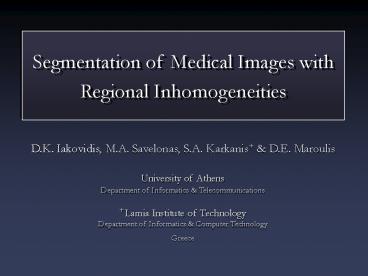????? t?t?? d?af??e?a? - PowerPoint PPT Presentation
Title:
????? t?t?? d?af??e?a?
Description:
Segmentation of Medical Images with Regional Inhomogeneities D.K. Iakovidis, M.A. Savelonas, S.A. Karkanis+ & D.E. Maroulis University of Athens – PowerPoint PPT presentation
Number of Views:19
Avg rating:3.0/5.0
Title: ????? t?t?? d?af??e?a?
1
Segmentation of Medical Images with Regional
Inhomogeneities
D.K. Iakovidis, M.A. Savelonas, S.A. Karkanis
D.E. Maroulis
University of Athens Department of Informatics
Telecommunications
Lamia Institute of Technology Department of
Informatics Computer Technology
Greece
2
Homogeneity
What is homogeneity? The quality of being of
uniform throughout in composition or structure
What is uniformity? A condition in which
everything is regular and unvarying
(The American Heritage Dictionary of the English
Language)
3
Regional homogeneity
4
Regional inhomogeneity
5
Regional inhomogeneity
6
Aim of study
Medical image segmentation Accurate delineation
of abnormal findings by excluding the regional
inhomogeneities
7
Aim of study
The shape of a clinical finding is usually
considered as a risk factor for various
malignancies
8
Background
Pioneering studies appeared in early 1970s J.
Sklansky D. Ballard, Tumor Detection in
Radiographs, Computers and Biomedical Research,
vol. 6, no. 4, pp. 299-321, 1973.
9
Background
- Since then a variety of medical image
segmentation methods have been proposed - Thresholding
- Region growing
- Clustering
- Classification
- Morphological operations
- Fuzzy approaches
- Drawbacks
- Sensitive to noise
- Sensitive to inhomogeneities
10
Background
- General review papers
- J.S. Duncan N. Ayache,
- Medical Image Analysis Progress Over Two
Decades and The Challenges Ahead, IEEE Trans.
Pattern Analysis Machine Intelligence, vol. 22,
pp. 85-106, 2000. - D. L. Pham, C. Xu J. L. Prince,
- Current Methods in Medical Image Segmentation,
Annual Review of Biomedical Engineering, vol. 2,
pp. 315-338, 2000.
11
Background
- State of the art approaches for shape recovery in
medical images include the level set deformable
models - Special review papers
- J.S. Suri et al.,
- Shape Recovery Algorithms Using Level Sets in
2-D/3-D Medical Imagery A State-of-the-Art
Review, ???? Trans. on Inf. Tech. in
Biomedicine, vol. 6, no. 1, pp. 8-28, Mar. 2002. - T. McInerney D. Terzopoulos,
- Deformable Models in Medical Image Analysis A
Survey, Med Image Analysis, vol. 1, pp. 91-108,
1996.
12
Deformable models
- Deformation of initial contours
- Initial contours are deformed towards the
boundaries of the image regions to be segmented - Energy functional minimization
- The functional is designed so that its global
minimum is reached at the target boundaries
13
Level-Set deformable models
- Deformable surface
- The surface is a function ?(x, y) of image
intensities - Contours are obtained for ?(x, y) 0
- The contours are formed by the zero level set of
?(x, y)
14
Active Contour Without Edges model
- Contour
- Energy functional
- Seek for
(Chan Vesse, 2001)
15
Active Contour Without Edges model
- Finally ?(x, y) is obtained by solving
- Basic assumption
- The image u0 is formed by two regions of
approximately piecewise-constant intensities of
distinct values c1 and c2.
(Chan Vesse, 2001)
16
The need for a new model
How piecewise-constant really are the intensities
of medical images with regional inhomogeneities?
17
The proposed model
Coping with regional inhomogeneities We propose
a new model that considers sparse foreground and
background from which the regional
inhomogeneities are excluded.
18
The proposed model
Recall that ?(x, y) is obtained by solving
where
19
The proposed model
Recall that ?(x, y) is obtained by solving
where
20
The proposed model
The delta term is estimated as follows
for
21
?(x, y)
22
?(x, y)
23
The proposed model
Recall that ?(x, y) is obtained by solving
where
24
The proposed model
Recall that ?(x, y) is obtained by solving
where
25
Setup of the experiments
- 38 medical images
- Endoscopic gastric ulcers
- Ultrasound parotid tumors thyroid nodules
- Image properties
- Dimensions 256x256 pixels
- Grey level depth 8-bit
- Segmentation quality measure
- Overlap value
26
Summary of results
27
Output images
96.4
98.1
94.2
88.4
28
Output video 1/3
89.2 3 min
Thyroid nodule and small initial contour
29
Output video 2/3
98.9 47 sec
Thyroid nodule and large initial contour
30
Output video 3/3
98.1 47 sec
Gastric ulcer
31
Conclusions
- We have introduced a novel, improved deformable
model based on the ACWE model - The new model
- assumes piecewise constancy over sparse regions
outside and inside the active contour - was applied for the segmentation of medical
images with regional inhomogeneities - outperforms the ACWE model in the delineation of
abnormal tissue masses - works better for images with more prevalent
regional inhomogeneities
32
Future work
- Systematic evaluation on larger datasets of
medical images acquired on regular basis - Investigation of automatic parameter tuning
approaches - Integration of the proposed model in a medical
decision support system
33
(No Transcript)
34
Thank you































